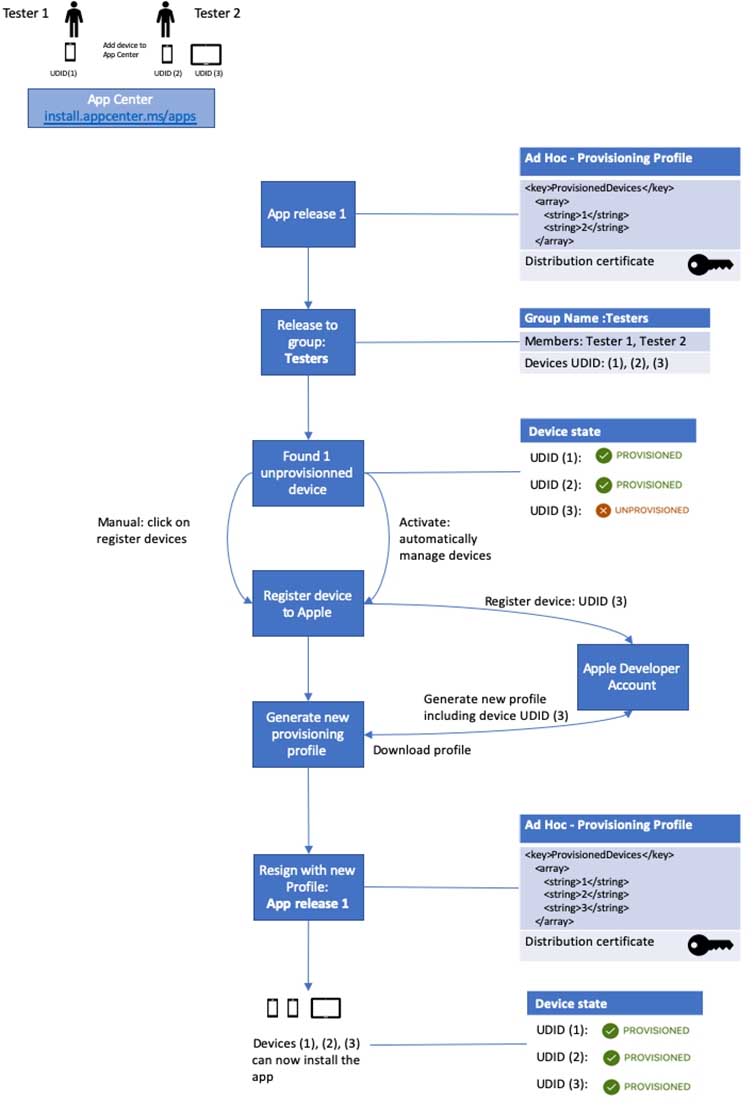AZ-400 : Microsoft Azure DevOps Solutions : Part 14
AZ-400 : Microsoft Azure DevOps Solutions : Part 14
-
DRAG DROP
You are defining release strategies for two applications as shown in the following table.

AZ-400 Microsoft Azure DevOps Solutions Part 14 Q01 155 Which release strategy should you use for each application? To answer, drag the appropriate release strategies to the correct applications. Each release strategy may be used once, more than once, or not at all. You may need to drag the split bar between panes or scroll to view content.
NOTE: Each correct selection is worth one point.

AZ-400 Microsoft Azure DevOps Solutions Part 14 Q01 156 Question 
AZ-400 Microsoft Azure DevOps Solutions Part 14 Q01 156 Answer Explanation:App1: Canary deployment
With canary deployment, you deploy a new application code in a small part of the production infrastructure. Once the application is signed off for release, only a few users are routed to it. This minimizes any impact.With no errors reported, the new version can gradually roll out to the rest of the infrastructure.
App2: Rolling deployment:
In a rolling deployment, an application’s new version gradually replaces the old one. The actual deployment happens over a period of time. During that time, new and old versions will coexist without affecting functionality or user experience. This process makes it easier to roll back any new component incompatible with the old components.Incorrect Answers:
Blue/Green deploymentA blue/green deployment is a change management strategy for releasing software code. Blue/green deployments, which may also be referred to as A/B deployments require two identical hardware environments that are configured exactly the same way. While one environment is active and serving end users, the other environment remains idle.
Blue/green deployments are often used for consumer-facing applications and applications with critical uptime requirements. New code is released to the inactive environment, where it is thoroughly tested. Once the code has been vetted, the team makes the idle environment active, typically by adjusting a router configuration to redirect application program traffic. The process reverses when the next software iteration is ready for release.
-
Note: This question is part of a series of questions that present the same scenario. Each question in the series contains a unique solution that might meet the stated goals. Some question sets might have more than one correct solution, while others might not have a correct solution.
After you answer a question in this section, you will NOT be able to return to it. As a result, these questions will not appear in the review screen.
You have an approval process that contains a condition. The condition requires that releases be approved by a team leader before they are deployed.
You have a policy stating that approvals must occur within eight hours.
You discover that deployment fail if the approvals take longer than two hours.
You need to ensure that the deployments only fail if the approvals take longer than eight hours.
Solution: From Post-deployment conditions, you modify the Timeout setting for post-deployment approvals.
Does this meet the goal?
- Yes
- No
Explanation:
Use Pre-deployments conditions instead.
Use a gate instead of an approval instead. -
DRAG DROP
You have an Azure DevOps organization named Contoso.
You have 10 Azure virtual machines that run Windows Server 2019. The virtual machines host an application that you build and deploy by using Azure Pipelines. Each virtual machine has the Web Server (IIS) role installed and configured.
You need to ensure that the web server configurations on the virtual machines is maintained automatically. The solution must provide centralized management of the configuration settings and minimize management overhead.
Which four actions should you perform in sequence? To answer, move the appropriate actions from the list of actions to the answer area and arrange them in the correct order.

AZ-400 Microsoft Azure DevOps Solutions Part 14 Q03 157 Question 
AZ-400 Microsoft Azure DevOps Solutions Part 14 Q03 157 Answer Explanation:Step1: Create an Azure Automation account.
An Azure Automation account is required.Step 2: Install the custom Desired State Configuration (DSC) extension on the virtual machines
Under the hood, and without an administrator having to remote into a VM, the Azure VM Desired State Configuration extension registers the VM with Azure Automation State Configuration.Step 3: Onboard the virtual machines to the Azure Automation account.
Step 4: Compile the Desired State Configuration (DSC) configuration.
Create a DSC configuration and compile it. -
You have a free tier of an Azure DevOps organization named Contoso. Contoso contains 10 private projects. Each project has multiple jobs with no dependencies. The build process requires access to resource files located in an on-premises file system.
You frequently run the jobs on five self-hosted agents but experience long build times and frequently queued builds.
You need to minimize the number of queued builds and the time it takes to run the builds.
What should you do?
- Configure the pipelines to use the Microsoft-hosted agents.
- Register additional self-hosted agents.
- Purchase self-hosted parallel jobs.
- Purchase Microsoft-hosted parallel jobs.
Explanation:If you want Azure Pipelines to orchestrate your builds and releases, but use your own machines to run them, use self-hosted parallel jobs. For self-hosted parallel jobs, you’ll start by deploying our self-hosted agents on your machines. You can register any number of these self-hosted agents in your organization.
Incorrect:
Not D: Microsoft-hosted CI/CD
If you want to run your jobs on machines that Microsoft manages, use Microsoft-hosted parallel jobs. Your jobs run on our pool of Microsoft-hosted agents.We provide a free tier of service by default in every organization.
-
SIMULATION
You need to ensure that an Azure web app named az400-9940427-main supports rolling upgrades. The solution must ensure that only 10 percent of users who connect to az400-9940427-main use update versions of the app.
The solution must minimize administrative effort.
To complete this task, sign in to the Microsoft Azure portal.
- See explanation below.
Explanation:Set up staging environments in Azure App Service
1. Open Microsoft Azure Portal
2. Log into your Azure account, select your app’s resource page, in the left pane, select Deployment slots > Add Slot.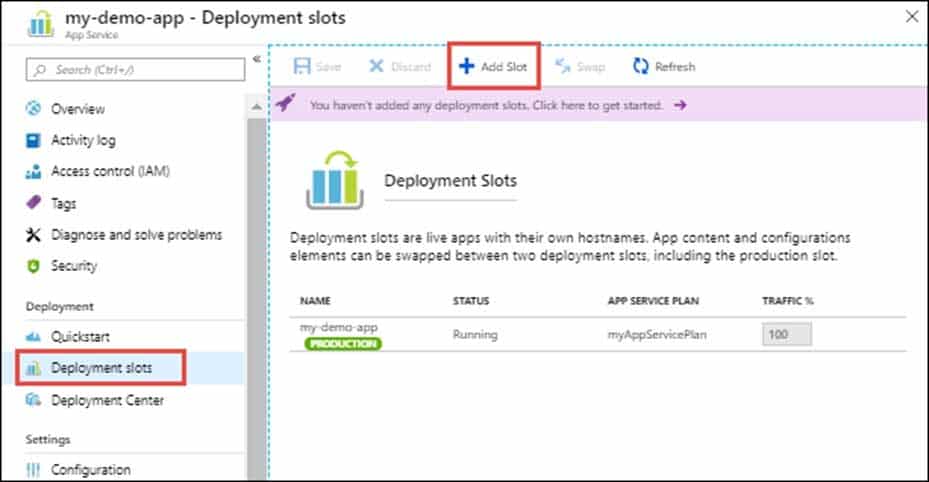
AZ-400 Microsoft Azure DevOps Solutions Part 14 Q05 158 3. In the Add a slot dialog box, give the slot a name, and select whether to clone an app configuration from another deployment slot. Select Add to continue.
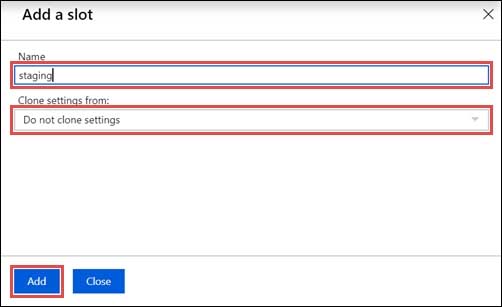
AZ-400 Microsoft Azure DevOps Solutions Part 14 Q05 159 4. After the slot is added, select Close to close the dialog box. The new slot is now shown on the Deployment slots page. By default, Traffic % is set to 0 for the new slot, with all customer traffic routed to the production slot.
5. Select the new deployment slot to open that slot’s resource page.
AZ-400 Microsoft Azure DevOps Solutions Part 14 Q05 160 6. Change TRAFFIC % to 10
-
You have an Azure DevOps project named Project1 and an Azure subscription named Sub1. Sub1 contains an Azure SQL database named DB1.
You need to create a release pipeline that uses the Azure SQL Database Deployment task to update DB1.
Which artifact should you deploy?
- a BACPAC
- a DACPAC
- an LDF file
- an MDF file
Explanation:Use Azure SQL Database Deployment task in a build or release pipeline to deploy to Azure SQL DB using a DACPAC or run scripts using SQLCMD.
-
HOTSPOT
You have a project in Azure DevOps.
You plan to create a build pipeline that will deploy resources by using Azure Resource Manager templates. The templates will reference secrets stored in Azure Key Vault.
You need to ensure that you can dynamically generate the resource ID of the key vault during template deployment.
What should you include in the template? To answer, select the appropriate options in the answer area.
NOTE: Each correct selection is worth one point.
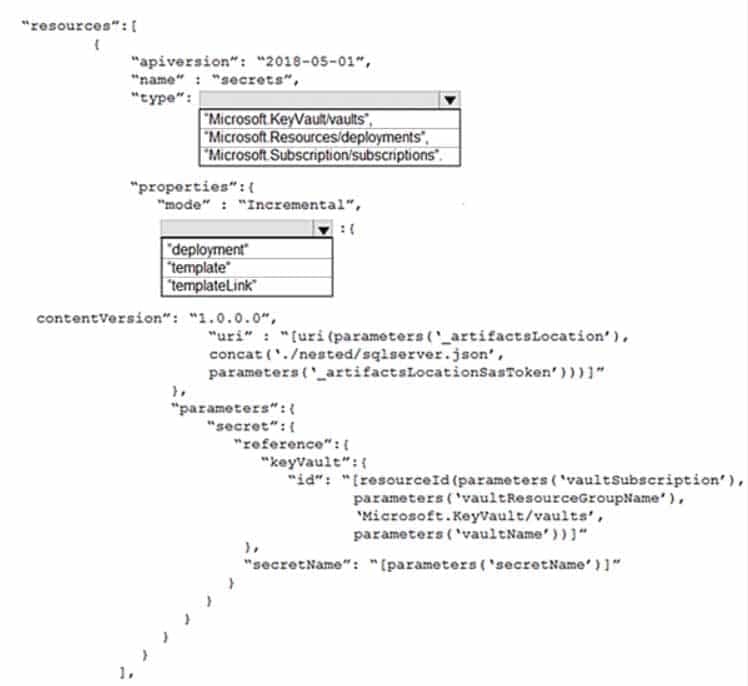
AZ-400 Microsoft Azure DevOps Solutions Part 14 Q07 161 Question 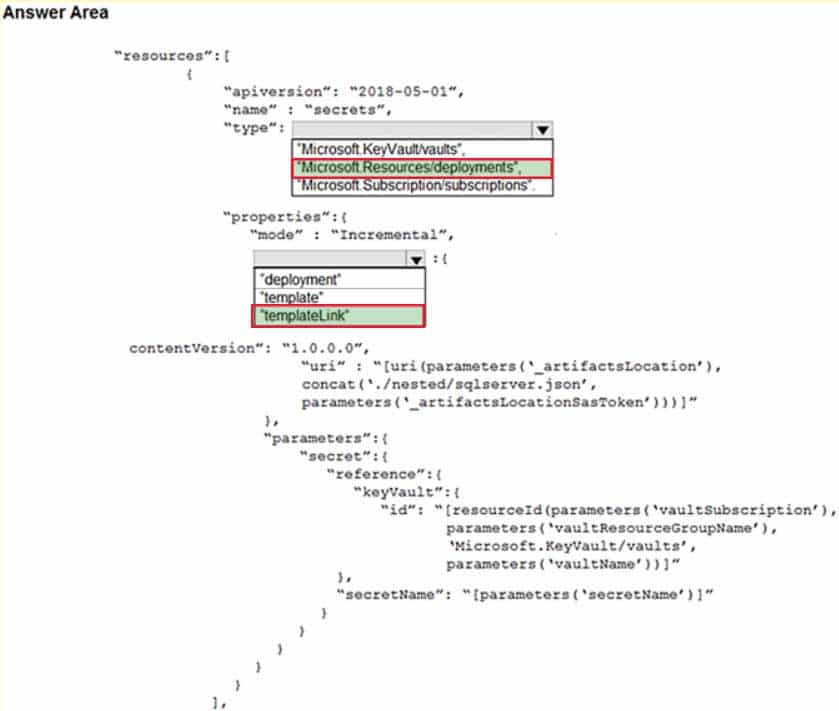
AZ-400 Microsoft Azure DevOps Solutions Part 14 Q07 161 Answer Explanation:Box 1: “Microsoft.Resources/deployments”
Reference a secret with dynamic ID. You need to reference a key vault secret that varies based on the current deployment.Example:
“resources”: [
{
“apiVersion”: “2018-05-01”,
“name”: “dynamicSecret”,
“type”: “Microsoft.Resources/deployments”,
“properties”: {
“mode”: “Incremental”,
“templateLink”: {Box 2: “templateLink”
In your parent template, you add the linked template and pass in a parameter that contains the dynamically generated resource ID. -
Your company has a project in Azure DevOps for a new web application.
The company uses ServiceNow for change management.
You need to ensure that a change request is processed before any components can be deployed to the production environment.
What are two ways to integrate ServiceNow into the Azure DevOps release pipeline? Each correct answer presents a complete solution.
NOTE: Each correct selection is worth one point.
- Define a deployment control that invokes the ServiceNow REST API.
- Define a pre-deployment gate before the deployment to the Prod stage.
- Define a deployment control that invokes the ServiceNow SOAP API.
- Define a post-deployment gate after the deployment to the QA stage.
Explanation:An example of a release pipeline that can be modeled through a release pipeline in shown below:
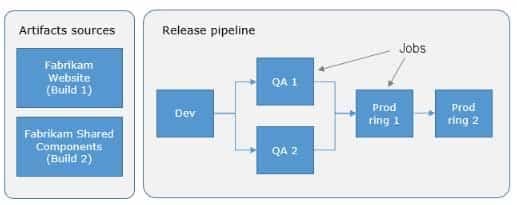
AZ-400 Microsoft Azure DevOps Solutions Part 14 Q08 162 In this example, a release of a website is created by collecting specific versions of two builds (artifacts), each from a different build pipeline. The release is first deployed to a Dev stage and then forked to two QA stages in parallel. If the deployment succeeds in both the QA stages, the release is deployed to Prod ring 1 and then to Prod ring 2. Each production ring represents multiple instances of the same website deployed at various locations around the globe.
-
Your company develops an application named App1 that is deployed in production.
As part of an application update, a new service is being added to App1. The new service requires access to an application named App2 that is currently in development.
You need to ensure that you can deploy the update to App1 before App2 becomes available. You must be able to enable the service in App1 once App2 is deployed.
What should you do?
- Implement a feature flag.
- Create a fork in the build.
- Create a branch in the build.
- Implement a branch policy.
Explanation:Feature flags support a customer-first DevOps mindset, to enable (expose) and disable (hide) features in a solution, even before they are complete and ready for release.
Incorrect Answers:
C: Branch policies are an important part of the Git workflow and enable you to:
Isolate work in progress from the completed work in your master branch
Guarantee changes build before they get to master -
You have a private distribution group that contains provisioned and unprovisioned devices.
You need to distribute a new iOS application to the distribution group by using Microsoft Visual Studio App Center.
What should you do?
- Request the Apple ID associated with the user of each device.
- Register the devices on the Apple Developer portal.
- Create an active subscription in App Center Test.
- Add the device owner to the organization in App Center.
Explanation:When releasing an iOS app signed with an ad-hoc or development provisioning profile, you must obtain tester’s device IDs (UDIDs), and add them to the provisioning profile before compiling a release. When you enable the distribution group’s Automatically manage devices setting, App Center automates the before mentioned operations and removes the constraint for you to perform any manual tasks. As part of automating the workflow, you must provide the user name and password for your Apple ID and your production certificate in a .p12 format.
App Center starts the automated tasks when you distribute a new release or one of your testers registers a new device. First, all devices from the target distribution group will be registered, using your Apple ID, in your developer portal and all provisioning profiles used in the app will be generated with both new and existing device ID. Afterward, the newly generated provisioning profiles are downloaded to App Center servers.
-
You are developing an iOS application by using Azure DevOps.
You need to test the application manually on 10 devices without releasing the application to the public.
Which two actions should you perform? Each correct answer presents part of the solution.
NOTE: Each correct selection is worth one point.
- Create a Microsoft Intune device compliance policy.
- Deploy a certificate from an internal certification authority (CA) to each device.
- Register the application in the iTunes store.
- Onboard the devices into Microsoft Intune.
- Distribute a new release of the application.
- Register the IDs of the devices in the Apple Developer portal.
Explanation:B: Follow these steps to register the devices:
Select the Register devices button.
A dialog prompts for your username and password used in the Apple Developer portal.
Once you sign in with your Apple username and password, App Center adds the unprovisioned devices to both your Apple developer account and the releases provisioning profile.
Optionally you can upload a .p12 file to re-sign the app and distribute it to the newly added devices. Read more on how to generate a .p12 file.F: Registering a device means making it part of the list of devices on the Apple Developer portal that can then be included in a provisioning profile.
Incorrect Answers:
C: Only register the application in the iTunes store when it is ready for public release. -
You have a private distribution group that contains provisioned and unprovisioned devices.
You need to distribute a new iOS application to the distribution group by using Microsoft Visual Studio App Center.
What should you do?
- Select Register devices and sign my app.
- Create an active subscription in App Center Test.
- Create an unsigned build.
- Add the device owner to the collaborators group.
-
SIMULATION
You plan to deploy a website that will be hosted in two Azure regions.
You need to create an Azure Traffic Manager profile named az40011566895n1-tm in a resource group named RG1lod11566895. The solution must ensure that users will always connect to a copy of the website that is in the same country.
To complete this task, sign in to the Microsoft Azure portal.
- See explanation below.
Explanation:1. Go to the Azure portal, navigate to Traffic Manager profiles and click on the Add button to create a routing profile.

AZ-400 Microsoft Azure DevOps Solutions Part 14 Q13 164 2, In the Create Traffic Manager profile, enter, or select these settings:
Name: az40011566895n1-tm
Routing method: Geographic
Resource group: RG1lod11566895
AZ-400 Microsoft Azure DevOps Solutions Part 14 Q13 165 Note: Traffic Manager profiles can be configured to use the Geographic routing method so that users are directed to specific endpoints (Azure, External or Nested) based on which geographic location their DNS query originates from. This empowers Traffic Manager customers to enable scenarios where knowing a user’s geographic region and routing them based on that is important.
-
Your company has an on-premises Bitbucket Server that is used for Git-based source control. The server is protected by a firewall that blocks inbound Internet traffic.
You plan to use Azure DevOps to manage the build and release processes.
Which two components are required to integrate Azure DevOps and Bitbucket? Each correct answer presents part of the solution.
NOTE: Each correct selection is worth one point.
- a deployment group
- a Microsoft-hosted agent
- service hooks
- a self-hosted agent
- an External Git service connection
Explanation:E: GitLab CI/CD can be used with GitHub or any other Git server such as BitBucket. Instead of moving your entire project to GitLab, you can connect your external repository to get the benefits of GitLab CI/CD.
Note: When a pipeline uses a remote, 3rd-party repository host such as Bitbucket Cloud, the repository is configured with webhooks that notify Azure Pipelines Server or TFS when code has changed and a build should be triggered. Since on-premises installations are normally protected behind a firewall, 3rd-party webhooks are unable to reach the on-premises server. As a workaround, you can use the External Git repository type which uses polling instead of webhooks to trigger a build when code has changed.
-
HOTSPOT
Your company uses Git as a source code control system for a complex app named App1.
You plan to add a new functionality to App1.
You need to design a branching model for the new functionality.
Which branch lifetime and branch time should you use in the branching model? To answer, select the appropriate options in the answer area.
NOTE: Each correct selection is worth one point.
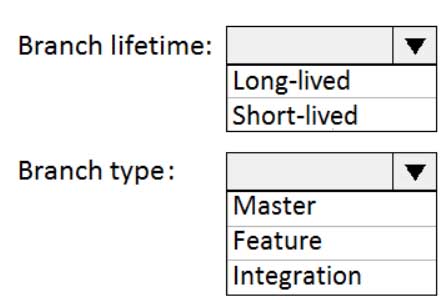
AZ-400 Microsoft Azure DevOps Solutions Part 14 Q15 166 Question 
AZ-400 Microsoft Azure DevOps Solutions Part 14 Q15 166 Answer Explanation:Branch lifetime: Short-lived
Branch type: Feature
Feature branches are used when developing a new feature or enhancement which has the potential of a development lifespan longer than a single deployment. When starting development, the deployment in which this feature will be released may not be known. No matter when the feature branch will be finished, it will always be merged back into the master branch. -
You have a project in Azure DevOps.
You plan to deploy a self-hosted agent by using an unattended configuration script.
Which two values should you define in the configuration script? Each correct answer presents part of the solution.
NOTE: Each correct selection is worth one point.
- authorization credentials
- the project name
- the deployment group name
- the organization URL
- the agent pool name
Explanation:Unattended config:
The agent can be set up from a script with no human intervention. You must pass –unattended and the answers to all questions.To configure an agent, it must know the URL to your organization or collection and credentials of someone authorized to set up agents. All other responses are optional.
-
HOTSPOT
You have an Azure virtual machine named VM1 that runs Linux.
You plan to deploy the Desired State Configuration (DSC) extension to VM1.
You need to grant the Log Analytics agent the appropriate directory permissions.
How should you complete the command? To answer, select the appropriate options in the answer area.
NOTE: Each correct selection is worth one point.

AZ-400 Microsoft Azure DevOps Solutions Part 14 Q17 167 Question 
AZ-400 Microsoft Azure DevOps Solutions Part 14 Q17 167 Answer Explanation:Box 1: rwx
The Log Analytics agent for Linux runs as the omsagent user. To grant >write permission to the omsagent user, run the command setfacl -m u:omsagent:rwx /tmp.Box 2: /tmp
Deploying DSC to a Linux node uses the /tmp folder. -
HOTSPOT
You are using PowerShell to administer Azure Log Analytics workspaces.
You need to list the available workspaces and their properties.
How should you complete the command? To answer, select the appropriate options in the answer area.
NOTE: Each correct selection is worth one point.

AZ-400 Microsoft Azure DevOps Solutions Part 14 Q18 168 Question 
AZ-400 Microsoft Azure DevOps Solutions Part 14 Q18 168 Answer Explanation:Box 1: Get-AzResource
Use the following command to examine the access control mode for all workspaces in the subscription:PowerShell
Get-AzResource -ResourceType Microsoft.OperationalInsights/workspaces -ExpandProperties | foreach {$_.Name + “: ” + $_.Properties.features.enableLogAccessUsingOnlyResourcePermissions
Box 2: -ResourceType
-
You have Azure Pipelines and GitHub integrated as a source code repository.
The build pipeline has continuous integration enabled.
You plan to trigger an automated build whenever code changes are committed to the repository.
You need to ensure that the system will wait until a build completes before queuing another build.
What should you implement?
- path filters
- batch changes
- scheduled builds
- branch filters
Explanation:Batching CI runs
If you have many team members uploading changes often, you may want to reduce the number of runs you start. If you set batch to true, when a pipeline is running, the system waits until the run is completed, then starts another run with all changes that have not yet been built.Example:
# specific branch build with batching
trigger:
batch: true
branches:
include:
– masterTo clarify this example, let us say that a push A to master caused the above pipeline to run. While that pipeline is running, additional pushes B and C occur into the repository. These updates do not start new independent runs immediately. But after the first run is completed, all pushes until that point of time are batched together and a new run is started.
-
You are using GitHub as a source code repository.
You create a client-side Git hook on the commit-msg event. The hook requires that each commit message contain a custom work item tag.
You need to make a commit that does not have a work item tag.
Which git commit parameter should you use?
-
--squash
-
--no-verify -
--message ''
-
--no-post-rewrite
Explanation:
The commit-msg hook is invoked by git-commit and git-merge, and can be bypassed with the –no-verify option. -
-
Case Study
This is a case study. Case studies are not timed separately. You can use as much exam time as you would like to complete each case. However, there may be additional case studies and sections on this exam. You must manage your time to ensure that you are able to complete all questions included on this exam in the time provided.
To answer the questions included in a case study, you will need to reference information that is provided in the case study. Case studies might contain exhibits and other resources that provide more information about the scenario that is described in the case study. Each question is independent of the other questions in this case study.
At the end of this case study, a review screen will appear. This screen allows you to review your answers and to make changes before you move to the next section of the exam. After you begin a new section, you cannot return to this section.
To start the case study
To display the first question in this case study, click the Next button. Use the buttons in the left pane to explore the content of the case study before you answer the questions. Clicking these buttons displays information such as business requirements, existing environment, and problem statements. If the case study has an All Information tab, note that the information displayed is identical to the information displayed on the subsequent tabs. When you are ready to answer a question, click the Question button to return to the question.Overview
Litware, Inc. is an independent software vendor (ISV). Litware has a main office and five branch offices.
Existing Environment
Application Architecture
The company’s primary application is a single monolithic retirement fund management system based on ASP.NET web forms that use logic written in VB.NET. Some new sections of the application are written in C#.
Variations of the application are created for individual customers. Currently, there are more than 80 live code branches in the application’s code base.
The application was developed by using Microsoft Visual Studio. Source code is stored in Team Foundation Server (TFS) in the main office. The branch offices access the source code by using TFS proxy servers.
Architectural Issues
Litware focuses on writing new code for customers. No resources are provided to refactor or remove existing code. Changes to the code base take a long time, as dependencies are not obvious to individual developers.
Merge operations of the code often take months and involve many developers. Code merging frequently introduces bugs that are difficult to locate and resolve.
Customers report that ownership costs of the retirement fund management system increase continually. The need to merge unrelated code makes even minor code changes expensive.
Customers report that bug reporting is overly complex.
Requirements
Planned Changes
Litware plans to develop a new suite of applications for investment planning. The investment planning applications will require only minor integration with the existing retirement fund management system.
The investment planning applications suite will include one multi-tier web application and two iOS mobile applications. One mobile application will be used by employees; the other will be used by customers.
Litware plans to move to a more agile development methodology. Shared code will be extracted into a series of packages.
Litware has started an internal cloud transformation process and plans to use cloud-based services whenever suitable.
Litware wants to become proactive in detecting failures, rather than always waiting for customer bug reports.
Technical Requirements
The company’s investment planning applications suite must meet the following technical requirements:
– New incoming connections through the firewall must be minimized.
– Members of a group named Developers must be able to install packages.
– The principle of least privilege must be used for all permission assignments.
– A branching strategy that supports developing new functionality in isolation must be used.
– Members of a group named Team Leaders must be able to create new packages and edit the permissions of package feeds.
– Visual Studio App Center must be used to centralize the reporting of mobile application crashes and device types in use.
– By default, all releases must remain available for 30 days, except for production releases, which must be kept for 60 days.
– Code quality and release quality are critical. During release, deployments must not proceed between stages if any active bugs are logged against the release.
– The mobile applications must be able to call the share pricing service of the existing retirement fund management system. Until the system is upgraded, the service will only support basic authentication over HTTPS.
– The required operating system configuration for the test servers changes weekly. Azure Automation State Configuration must be used to ensure that the operating system on each test server is configured the same way when the servers are created and checked periodically.Current Technical Issue
The test servers are configured correctly when first deployed, but they experience configuration drift over time. Azure Automation State Configuration fails to correct the configurations.
Azure Automation State Configuration nodes are registered by using the following command.

AZ-400 Microsoft Azure DevOps Solutions Part 14 Q21 169 -
To resolve the current technical issue, what should you do to the Register-AzureRmAutomationDscNode command?
- Change the value of the ConfigurationMode parameter.
- Replace the Register-AzureRmAutomationDscNode cmdlet with
Register-AzureRmAutomationScheduledRunbook - Add the AllowModuleOverwrite parameter.
- Add the DefaultProfile parameter.
Explanation:Change the ConfigurationMode parameter from ApplyOnly to ApplyAndAutocorrect.
The Register-AzureRmAutomationDscNode cmdlet registers an Azure virtual machine as an APS Desired State Configuration (DSC) node in an Azure Automation account.
Scenario: Current Technical Issue
The test servers are configured correctly when first deployed, but they experience configuration drift over time. Azure Automation State Configuration fails to correct the configurations.
Azure Automation State Configuration nodes are registered by using the following command.

AZ-400 Microsoft Azure DevOps Solutions Part 14 Q21 170 -
Which branching strategy should you recommend for the investment planning applications suite?
- release isolation
- main only
- development isolation
- feature isolation
Explanation:Scenario: A branching strategy that supports developing new functionality in isolation must be used.
Feature isolation is a special derivation of the development isolation, allowing you to branch one or more feature branches from main, as shown, or from your dev branches.

AZ-400 Microsoft Azure DevOps Solutions Part 14 Q21 171 When you need to work on a particular feature, it might be a good idea to create a feature branch.
Incorrect Answers:
A: Release isolation introduces one or more release branches from main. The strategy allows concurrent release management, multiple and parallel releases, and codebase snapshots at release time.B: The Main Only strategy can be folder-based or with the main folder converted to a Branch, to enable additional visibility features. You commit your changes to the main branch and optionally indicate development and release milestones with labels.
C: Development isolation: When you need to maintain and protect a stable main branch, you can branch one or more dev branches from main. It enables isolation and concurrent development. Work can be isolated in development branches by feature, organization, or temporary collaboration.
-
What should you use to implement the code quality restriction on the release pipeline for the investment planning applications suite?
- a pre-deployment approval
- a deployment gate
- a post-deployment approval
- a trigger
Explanation:When a release is created from a release pipeline that defines approvals, the deployment stops at each point where approval is required until the specified approver grants approval or rejects the release (or re-assigns the approval to another user).
Scenario: Code quality and release quality are critical. During release, deployments must not proceed between stages if any active bugs are logged against the release.
-
HOTSPOT
How should you configure the release retention policy for the investment planning applications suite? To answer, select the appropriate options in the answer area.
NOTE: Each correct selection is worth one point.
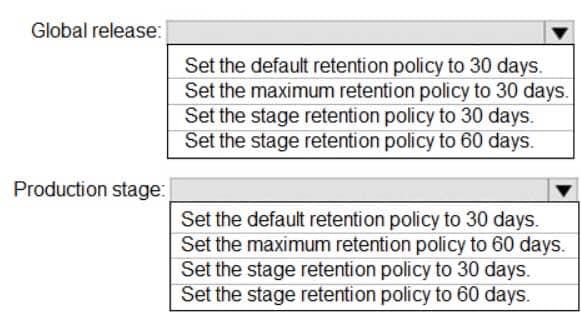
AZ-400 Microsoft Azure DevOps Solutions Part 14 Q21 172 Question 
AZ-400 Microsoft Azure DevOps Solutions Part 14 Q21 172 Answer Explanation:Scenario: By default, all releases must remain available for 30 days, except for production releases, which must be kept for 60 days.
Box 1: Set the default retention policy to 30 days
The Global default retention policy sets the default retention values for all the build pipelines. Authors of build pipelines can override these values.Box 2: Set the stage retention policy to 60 days
You may want to retain more releases that have been deployed to specific stages. -
HOTSPOT
Where should the build and release agents for the investment planning applications suite run? To answer, select the appropriate options in the answer area.
NOTE: Each correct selection is worth one point.

AZ-400 Microsoft Azure DevOps Solutions Part 14 Q21 173 Question 
AZ-400 Microsoft Azure DevOps Solutions Part 14 Q21 173 Answer Explanation:Box 1: A source control system
A source control system, also called a version control system, allows developers to collaborate on code and track changes. Source control is an essential tool for multi-developer projects.Box 2: A hosted service
To build and deploy Xcode apps or Xamarin.iOS projects, you’ll need at least one macOS agent. If your pipelines are in Azure Pipelines and a Microsoft-hosted agent meets your needs, you can skip setting up a self-hosted macOS agent.Scenario: The investment planning applications suite will include one multi-tier web application and two iOS mobile applications. One mobile application will be used by employees; the other will be used by customers.
-
- This is a case study. Case studies are not timed separately. You can use as much exam time as you would like to complete each case. However, there may be additional case studies and sections on this exam. You must manage your time to ensure that you are able to complete all questions included on this exam in the time provided.
To answer the questions included in a case study, you will need to reference information that is provided in the case study. Case studies might contain exhibits and other resources that provide more information about the scenario that is described in the case study. Each question is independent of the other questions in this case study.
At the end of this case study, a review screen will appear. This screen allows you to review your answers and to make changes before you move to the next section of the exam. After you begin a new section, you cannot return to this section.
To start the case study
To display the first question in this case study, click the Next button. Use the buttons in the left pane to explore the content of the case study before you answer the questions. Clicking these buttons displays information such as business requirements, existing environment, and problem statements. If the case study has an All Information tab, note that the information displayed is identical to the information displayed on the subsequent tabs. When you are ready to answer a question, click the Question button to return to the question.Overview
General Overview
Woodgrove Bank is a financial services company that has a main office in the United Kingdom.
Technical Requirements and Planned Changes
Planned Changes
Woodgrove Bank plans to implement the following project management changes:
– Implement Azure DevOps for project tracking.
– Centralize source code control in private GitHub repositories.
– Implement Azure Pipelines for build pipelines and release pipelines.Woodgrove Bank plans to implement the following changes to the identity environment:
– Deploy an Azure AD tenant named woodgrovebank.com.
– Sync the Active Directory domain to Azure AD.
– Configure App1 to use a service principal.
– Integrate GitHub with Azure AD.Woodgrove Bank plans to implement the following changes to the core apps:
– Migrate App1 to ASP.NET Core.
– Integrate Azure Pipelines and the third-party build tool used to develop App2.Woodgrove Bank plans to implement the following changes to the DevOps environment:
– Deploy App1 to Azure App Service.
– Implement source control for the DB1 schema.
– Migrate all the source code from TFS1 to GitHub.
– Deploy App2 to an Azure virtual machine named VM1.
– Merge the POC branch into the GitHub default branch.
– Implement an Azure DevOps dashboard for stakeholders to monitor development progress.Technical Requirements
Woodgrove Bank identifies the following technical requirements:
– The initial databases for new environments must contain both schema and reference data.
– An Azure Monitor alert for VM1 must be configured to meet the following requirements:
– Be triggered when average CPU usage exceeds 80 percent for 15 minutes.
– Calculate CPU usage averages once every minute.
– The commit history of the POC branch must replace the history of the default branch.
AZ-400 Microsoft Azure DevOps Solutions Part 14 Q22 174 – The Azure DevOps dashboard must display the metrics shown in the following table:
– Access to Azure DevOps must be restricted to specific IP addresses.
– Page load times for App1 must be captured and monitored.
– Administrative effort must be minimized.-
DRAG DROP
You are configuring the Azure DevOps dashboard. The solution must meet the technical requirements.
Which widget should you use for each metric? To answer, drag the appropriate widgets to the correct metrics. Each widget may be used once, more than once, or not at all. You may need to drag the split bar between panes or scroll to view content.
NOTE: Each correct selection is worth one point.
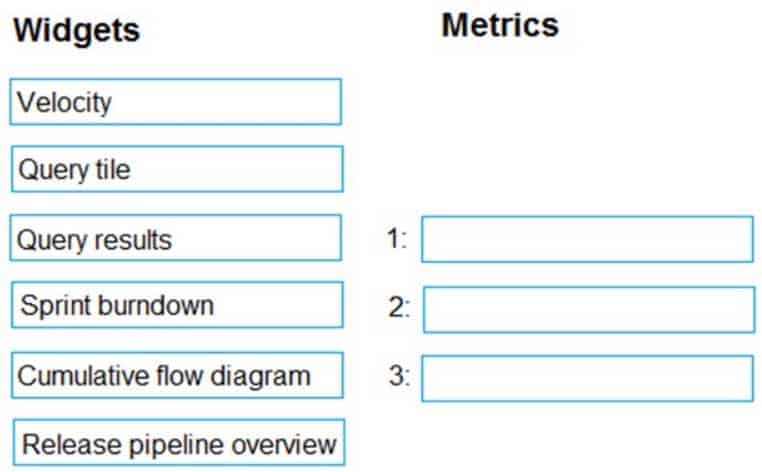
AZ-400 Microsoft Azure DevOps Solutions Part 14 Q22 175 Question 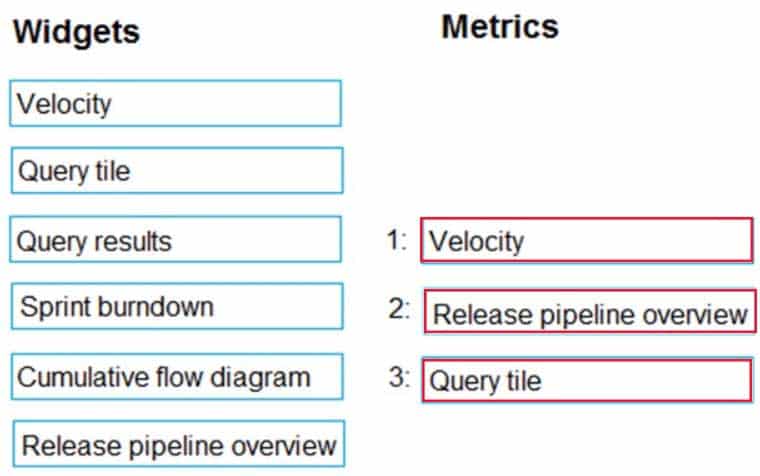
AZ-400 Microsoft Azure DevOps Solutions Part 14 Q22 175 Answer Explanation:Woodgrove Bank identifies the following technical requirements:
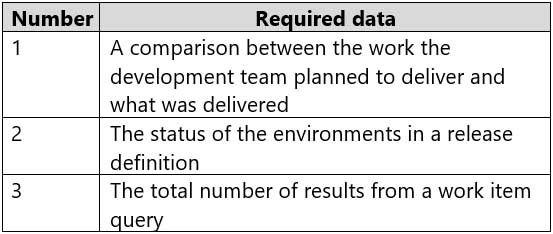
AZ-400 Microsoft Azure DevOps Solutions Part 14 Q22 176 The Azure DevOps dashboard must display the metrics shown in the following table:
Box 1: Velocity
Velocity displays your team velocity. It shows what your team delivered as compared to plan.Box 2: Release pipeline overview
Release pipeline overview shows the status of environments in a release definition.Box 3: Query tile
Query tile displays the total number of results from a query.
-
